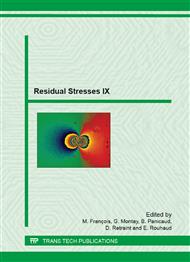p.538
p.544
p.550
p.556
p.562
p.568
p.574
p.580
p.586
Effect of Preloading on Local Residual Stresses Induced by Laser Surface Hardening of Steel
Abstract:
The effect of defined preloading in the tensile and compressive regime on the near surface (residual) stress distributions, which result from laser surface hardening, is systematically studied in-situ, i.e. under the applied preload and after unloading. Samples made of steel grade AISI 4140 are defined surface hardened by means of a high-power diode laser (HPDL) system during uniaxial compressive elastic loading at-300 MPa as well as during uniaxial elastic tensile loading at 300 MPa using a custom designed 4-point-bending device, which can be mounted on an X-ray diffractometer. The results of X-ray stress analysis were compared to data derived for a sample state unaffected by any preload. Without external loading compressive residual stresses are induced inside the process zone that are balanced by tensile residual stresses outside this zone. The investigations show that external loading in the tensile and compressive regime has a strong impact on the resulting lateral residual stress distribution in loading direction. The results further indicate that undesirable tensile residual stresses outside the process zone can even be suppressed by using a defined appropriate preloading in the tensile regime.
Info:
Periodical:
Pages:
562-567
Citation:
Online since:
August 2014
Authors:
Permissions:
Share:
Citation:


